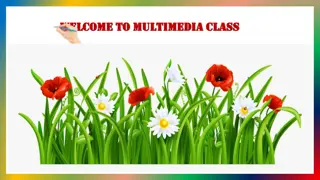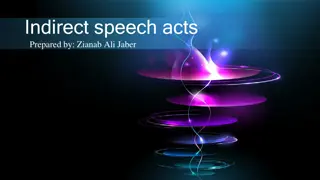Advanced Analytics in Indirect Taxation by Central Board of Indirect Taxes & Customs
The Central Board of Indirect Taxes & Customs in India leverages technology through ADVAIT to provide near real-time data capture, predictive analytics, and fraud detection in the realm of indirect taxation. This initiative enhances taxpayer service with cutting-edge data visualization, mobile acces
3 views • 28 slides
Prevention and Combating of Hate Crimes and Hate Speech Bill [B.9B.2018]
The Prevention and Combating of Hate Crimes and Hate Speech Bill aims to address incidents motivated by prejudices through the creation of offenses of hate crimes and hate speech. It seeks to prevent and combat these offenses by defining hate crimes, hate speech, and establishing measures for prosec
7 views • 18 slides
Stereotypes, Hate Speech, and Freedom of Speech
This lesson explores the topics of hate speech, stereotypes, and the boundary between freedom of speech and hate speech. It delves into the origins of hate speech, the connection between stereotyping and hate speech, and how stereotyping can lead to violence. The discussion also touches on the impor
4 views • 14 slides
Direct and Reported Speech in English
Explore the differences between direct and reported speech, learn how to convert direct speech into reported speech, and understand when to use each form in writing. Direct speech uses the speaker's actual words in quotes, while reported speech conveys the gist of what was said without using exact w
3 views • 20 slides
Speech Acts and Politeness in Linguistics
This informative content explores the concepts of speech acts, including direct and indirect speech acts, and the role of politeness in communication. It highlights how speakers convey intentions through their utterances, distinguishing between different speech acts such as requesting, commanding, a
2 views • 11 slides
Mastering the Art of Using Speech Marks for Direct Speech
Learn how to effectively use speech marks (inverted commas/quotations marks) to punctuate direct speech. Discover the rules for using speech marks, examples of correctly punctuated sentences, and when to use question marks in speech. Enhance your writing skills with proper speech punctuation.
5 views • 27 slides
Indirect Speech Acts in Semantics
Speech acts can be direct or indirect, with indirect speech acts relying on implicature rather than literal meaning. This concept can lead to confusion, especially in cross-cultural communication. Explore the theories of J.L. Austin and John Searle regarding speech acts and performative utterances,
2 views • 16 slides
Mastering Direct and Indirect Speech: A Comprehensive Guide
Explore the world of direct and indirect speech with this in-depth lesson on narration. Learn how to speak using both methods, transform sentences from direct to indirect, and discover the nuances of backshift of tenses and adverbs. Gain a better understanding of how grammatical changes occur betwee
3 views • 31 slides
Exercise on Narrative Style Transformation
Practice changing the narrative style of given texts from direct to indirect speech. Improve your skills in transforming conversations while maintaining the meaning and essence of the original dialogue to prepare for examinations. Enhance your ability to narrate stories effectively by converting dir
1 views • 26 slides
Mastering Passage Narration: Learn How to Change Direct to Indirect Speech
Join the multimedia class to enhance your skills in passage narration. Explore the rules and techniques to transform direct speech into indirect speech. Practice through engaging activities and pair work to solidify your understanding. Improve your English 2nd Paper skills and excel in narrative wri
1 views • 23 slides
Intelligibility in Dysarthria: Survey of SLPs
Dysarthria is a speech disorder impacting speech processes, with neurological disruptions seen in conditions like ALS, traumatic brain injury, and Parkinson's disease. Intelligibility, the listener's understanding of speech, is crucial for quantifying dysarthria's impact. Factors like speech tasks,
1 views • 15 slides
Examples of Reported Speech Transformation
This content provides examples of how direct speech sentences are transformed into reported speech sentences. Various scenarios are depicted, such as a doctor advising a patient, a policeman warning a thief, requests from individuals to others, and commands given by authority figures. Each direct sp
2 views • 23 slides
Direct and Indirect Speech in English
Direct speech involves reporting exact words spoken, while indirect speech conveys the same message using different words. Learn about the rules for changing pronouns and key aspects of both direct and indirect speech. Master the art of transforming sentences from direct to indirect speech with ease
3 views • 15 slides
Assistive Speech System for Individuals with Speech Impediments Using Neural Networks
Individuals with speech impediments face challenges with speech-to-text software, and this paper introduces a system leveraging Artificial Neural Networks to assist. The technology showcases state-of-the-art performance in various applications, including speech recognition. The system utilizes featu
1 views • 19 slides
Freedom of Speech in Nomination Speech: Analysis and Insights
Exploring the boundaries of freedom of speech in a nomination speech for a student government candidate, highlighting elements that may not align with protected freedoms under the First Amendment. The speech emphasizes firm beliefs and dedication but raises questions about appropriateness and potent
0 views • 30 slides
Speech Therapy Guidelines and Medicare Regulations Overview
This content provides detailed information on writing person-centered functional goals in speech therapy, emphasizing SMART goals and best practices. It covers course descriptions, objectives, and Medicare regulations related to speech therapy services. The importance of reasonable and necessary evi
0 views • 90 slides
Direct and Indirect Speech in English Grammar Exercises
Study the concept of direct and indirect speech through examples and rules explained in the given content. Learn how to change sentences from direct to indirect speech by understanding reporting verbs and tense changes. Practice converting words indicating nearness to words showing distance for bett
5 views • 16 slides
Direct and Indirect Objects in Grammar
Direct and indirect objects are essential components of sentences, helping clarify the action and recipients involved. Direct objects receive the action directly, answering the questions "Whom?" or "What?" Indirect objects indicate to whom or for whom the action is done, always appearing between the
3 views • 12 slides
Mastering Narration: Rules and Examples in English Grammar
This educational content covers the topic of narration in English grammar, focusing on direct and indirect speech, rules for changing direct speech into indirect, and examples to illustrate the concepts. It includes information on teacher identity, learning outcomes, narration types, and practical e
3 views • 21 slides
Mastering Indirect Speech and Time Adverbials
Explore the nuances of indirect speech in English language with a focus on tense changes and adverbial phrases of time. Learn how to accurately report what someone said and correctly transform adverbs to match the context of the reported speech. Enhance your language skills with practical examples a
0 views • 5 slides
Direct and Reported Speech Punctuation
Distinguishing between direct and reported speech is essential. Direct speech quotes the exact words using inverted commas, while reported speech summarizes without the same words, often in the past tense. In direct speech, present tense and inverted commas are used but not in reported speech.
1 views • 31 slides
Rules for Changing Imperative Sentences in Reported Speech
Learn the rules for changing imperative sentences in reported speech with examples. Discover how to transform direct commands into indirect requests, advice, or orders. Understand the structure of reported speech when addressing a person. Explore how to add respect when "Sir" is present in the repor
0 views • 14 slides
Learn Direct and Indirect Speech in English: Grade 8 Lesson 7
Explore the transformation from direct to indirect speech in various tenses such as Simple Present, Present Continuous, Simple Past, Past Continuous, and Simple Future. Understand the changes in verbs and adverbs of time and place. Practice exercises to enhance your understanding.
0 views • 28 slides
Ensuring Free Speech Rights at Michigan State University
Michigan State University's Trustees emphasize the importance of protecting free speech on campus. The university's philosophy supports campus dissent, promoting a healthy exchange of ideas. Recent incidents, like protesters disrupting a speaker's event, raise concerns about safeguarding free speech
0 views • 11 slides
Indirect Speech Acts in Communication
Indirect speech acts involve utterances that appear as simple statements but are intended to convey a different meaning such as requests or commands. This form of communication can be seen in various cultural contexts, requiring the listener to interpret the intended illocutionary force behind the w
0 views • 12 slides
Fictional Speech and Phonostylistics in Literature
Delve into the realm of fictional speech and phonostylistics within literature, examining the representation of speech versus real speech, the encoding of spatial, social, and attitudinal markers, and the significance of fictional speech in creating immersive narratives. Discover how authors navigat
0 views • 30 slides
Direct vs Indirect Characterization in English Literature
Development of characters, known as characterization, is crucial in storytelling. There are two main ways to characterize: direct and indirect. Direct characterization involves explicitly stating the character's traits, while indirect characterization uses actions, thoughts, and interactions to reve
0 views • 15 slides
Cases of Hate Speech in Public and Student Speech Scenarios
The content discusses instances of hate speech in two different scenarios. In the public employee speech case, a building inspector's tweets lead to his firing and subsequent legal action. In the student speech case, a high school junior's involvement in a white nationalist demonstration causes disr
0 views • 16 slides
Characterization in Literature
Exploring the differences between direct and indirect characterization in literature, this content explains how authors convey character traits through actions, dialogue, thoughts, and interactions. It provides examples and types of indirect characterization, with a focus on speech, thoughts, effect
0 views • 34 slides
Indirect Speech Acts Performatives Course Tutor Prof. Ahmed Q. Abed, PhD by Hind Ibrahim Ismail
Deborah Tannen's experience in Greece illustrates how indirect speech acts can convey unintended meanings. Performatives, as discussed by J.L. Austin, are declarative sentences that do not simply describe but actively change reality. Understanding sentence meaning requires considering not just truth
0 views • 12 slides
Hate Speech and Fake News in the Balkans
This study delves into the prevalence of hate speech and fake news in the Balkans, shedding light on the harmful impact of such communication. It discusses the lack of an international legal definition for hate speech and explores how fake news spreads through fabricated stories, often disseminated
1 views • 27 slides
Treatment Approaches for Childhood Apraxia of Speech (CAS)
Childhood Apraxia of Speech (CAS) is a neurological speech disorder impacting speech precision and consistency. Despite the lack of a gold standard treatment due to limited well-controlled studies, various principles guide therapy approaches. Key features of CAS include inconsistent errors in speech
0 views • 36 slides
The Role of a Speech-Language Pathologist in Schools
As a Speech-Language Pathologist (SLP) in a school setting, your job involves assessing and treating children with communication disorders that impact their academic success and social interaction. Requirements in Kansas include a Master's degree, supervised clinical practicum, passing exams, and co
0 views • 24 slides
Indirect Speech: Examples and Practice
Indirect speech involves reporting what someone else has said without quoting them directly. In this content, you will find examples and exercises on how to convert direct speech into indirect speech, covering statements, commands, and requests. Practice transforming sentences like "My parents are v
2 views • 8 slides
Indirect Cost Concerns Under the Uniform Guidance
Overview of the indirect cost concerns under the Uniform Guidance issued by the U.S. Department of Education. The content covers the definition of indirect costs, typical expenditures, cognizant agency determination, and specific guidance for state and local education agencies. Important aspects suc
2 views • 41 slides
Indirect Questions and Reported Speech in English
Learn how to transform direct questions into indirect questions and reported speech in English. Gain insights into the structure, verb usage, and time shifting involved in these transformations through examples and illustrations.
0 views • 7 slides
Enhancing Elderly Care: Direct and Indirect Support Strategies
Implementing a care strategy for the elderly involves integrating both direct, personal care activities and indirect care tasks. This approach benefits two key target audiences, including millions with varying levels of dependency and informal carers. The positive impacts of indirect care include we
0 views • 7 slides
English 9th Grade - Reported Speech in Everyday Situations
In this English lesson for 9th graders, students learn about reported speech through a scenario where a student, Ana, asks her classmates for help with a research project. The classmates respond with reasons they cannot help, and Ana later recounts their responses using reported speech. The lesson a
0 views • 19 slides
REPORTED SPEECH 1
Reported speech is a method of narration used to convey what others have said at a specific time, commonly known as "he said/she said." It is vital in communication, especially in interviews and conversations. Learn about the two kinds of reported speech, its usage in the past, and examples to enhan
0 views • 8 slides
Meet Mrs. Mallory Foster - Speech-Language Pathologist
Mrs. Mallory Foster is a dedicated speech-language pathologist based in Enterprise, AL. With a strong educational background and a passion for helping children, she creates a fun and nurturing environment for speech therapy sessions. Mrs. Foster uses evidence-based practices, games, and various acti
0 views • 5 slides

![Prevention and Combating of Hate Crimes and Hate Speech Bill [B.9B.2018]](/thumb/60513/prevention-and-combating-of-hate-crimes-and-hate-speech-bill-b-9b-2018.jpg)





































